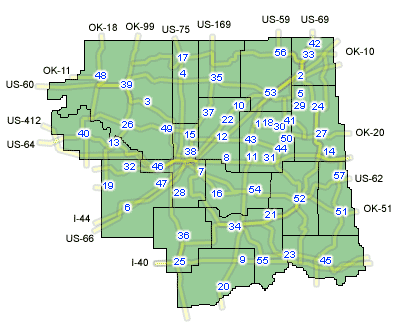Green Country, Oklahoma


From sprawling cattle ranches to curlicued Art Deco skyscrapers, Osage brush arbors to Route 66 diners, northeastern Oklahoma is where the American Dream met the American West. The area's Native American roots can be traced back to the prehistoric Spiro Mound Builders -- the story of the 12th century empire they built is told at Spiro Mounds Archaeological Park near Poteau. In the 19th Century, the Cherokee tribe built their capitol on the green banks of the Illinois River and Creek Indian councils met under a massive oak in "Tulsey Town." The Osage tribe moved from Kansas to Pawhuska, named for the Osage chief, on the border of the tall grass prairie; the tribe was confident the roots of the rich grass were so thick and deep the land would never be plowed by settlers. The discovery of vast seas of oil beneath the prairies changed the face of northeastern Oklahoma -- Tulsey Town became Tulsa, "Oil Capitol of the World," and nearby Bartlesville grew from a Delaware trading post to a cosmopolitan town boasting a Frank Lloyd Wright-designed skyscraper.
Explore Green Country
Immaculate Conception Catholic Church
This church is known widely as the "Cathedral of the Osage". Special permission from the Vatican had to be granted to depict living tribal members in the glorious stained glass that was crafted in Munich, Germany in 1919
Pawhuska, OK Historic ChurchesHistoric Garrett House Museum
This historic home was built in 1867 as the commanding officers residence, and is listed on the National Register of Historic Places. The three story home was part of the Fort Gibson Fort established in Indian Territory in 1824
Fort Gibson, OK MuseumsMemorial to the Confederate Dead
Erected in 1913 by the Colonial William Penn Adair Chapter of the Daughters of the Confederacy.
Tahlequah, OK MemorialsRogers University Conservation Education Reserve
Rogers University Conservation Education Reserve is a 120 acre natural resource conservation education facility adjacent to the main campus of Rogers University. Bird watching, wildlife observation, outdoor photography, walking trails, picnicking, and fishing are available.
Claremore, OK Learning CentersVinita Public Library
Vinita Public Library offers many services throughout the year. Bestsellers fly onto our shelves as soon as they're released. Large print titles, popular paperbacks, audio books and videos are available in great variety. Youngsters enjoy our annual Summer Reading Program and the best in children'
Vinita, OK LibrariesRadium Town and the Keller Bath House
An area in the north section of Claremore was once known as RADIUM TOWN. George Eaton owned the first oil company in town. In 1903, he was drilling east of town for oil or gas. Instead, he found a "rotten-egg-smelling"
Claremore, OK Historic BuildingsBlue Ribbon Downs
Blue Ribbon Downs is Oklahoma's oldest racing facility and first pari-mutuel race track. Located on 165 acres bordered on the south by I-40 and on the north by Highway 64, is only 20 miles west of Fort Smith, Arkansas, 101 miles southeast of Tulsa and 159
Sallisaw, OK Race TracksWagoner County Courthouse & Memorial Walk
The Wagoner County Courthouse was built in 1939 replacing the original courthouse that was built in 1897 which also served as the federal building. Located on the front lawn is a Veteran'
Wagoner, OK Historic CourthousesMurrell Home
The Murrell Home was built in the new Cherokee Nation about 1845 by George M. Murrell. Murrell was a native Virginain who married Minerva Ross in 1834. Minerva was a member of a wealthy mixed-blood Cherokee/Scottish family, and the niece of Chief John Ross.
Tahlequah, OK MuseumsWhite Hair Memorial
This Osage center features a collection of Lillie Morrell Burkheart. It is the former home of the first woman to be nominated to the Osage Tribal Council and a descendant of Chief Pawhuska. Ribbonwork and other cultural items are on display.
Hominy, OK MemorialsOsage County Historical Museum
One of the three museums in and around Pawhuska, the Osage County Historical Museum is housed in the historic Santa Fe Depot built in 1922
Pawhuska, OK Museums